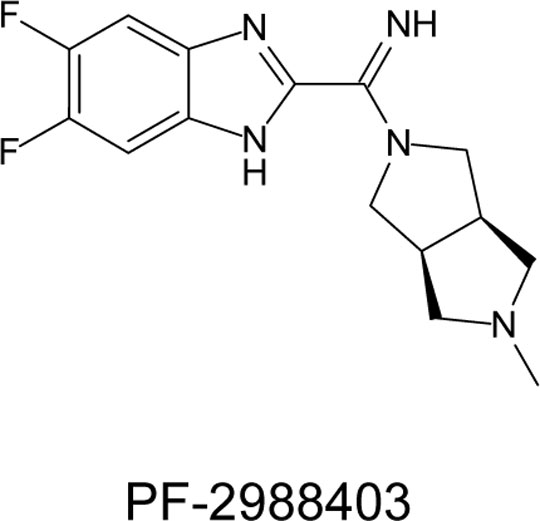Print version
Search Pub Med
Translation of species differences in histamine H4 pharmacology with PF-2988403 Expression of the histamine H4 receptor is mainly restricted to bone marrow, spleen and circulating leukocytes, and thus represents an anti-inflammatory target. The distribution of the target is broadly conserved across species; however the sequence homology is not. Hence, diverse ranges of potency and functional effects across the species by the same compound could be possible. PF-2988403 is a novel selective H4 antagonist, and here we disclose its structure and describe its’ in vitro and corresponding in vivo profile in the rat.

In vitro potency and selectivity was assessed in HEK-293T cells expressing either the human recombinant H1/2/3/4 receptors separately or the mouse, rat, guinea-pig, dog or monkey H4 receptor using inhibition of [3H]-pyrilamine (H1), tiotidine (H2), N-α-methyl histamine (H3) and histamine (H4) binding. The functional effects were assessed by stimulating the cells with forskolin and tested as agonist/inverse agonist and as antagonists of a single concentration (∼ED80) of histamine. In vivo, the oral administration of PF-2988403 at doses from 2.6 to 720 mg/kg/day for 4 days to groups of five male rats was explored to determine any physiological or pathophysiological effects. PF-2988403 produced concentration related changes in [3H]-ligand binding to all human histamine receptor subtypes with Ki’s of 9.55 nM (5.19-17.6; n = 5) at H4, and >2μM at H1, 2 and 3 (n = 2). The profile of PF-2988403 differed at human and animal H4 receptors, exhibiting a range of functional effects, from neutral antagonist (human H4), to partial agonist and full agonist (rat H4) (n = 5-7). In vivo in the rat (n = 5), the effects were consistent with a full agonist, i.e. pro-inflammatory effects (e.g. changes in peripheral blood / bone marrow and spleen), thereby supporting the theory that an H4 antagonist would be anti-inflammatory. PF-2988403 is an ‘H4 antagonist’ demonstrating a range of in vitro pharmacologies which translate in vivo in the rat. |
|

